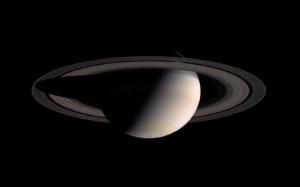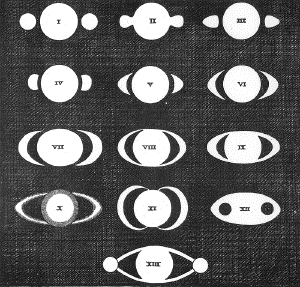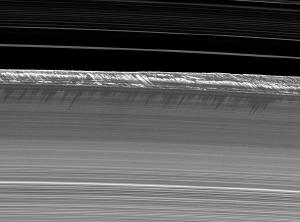Blog
Lord of the Rings
31 March 2014
 NASA
NASAAll of the outer planets (and at least one asteroid) have ring systems, but none are nearly so bright and extensive as those of Saturn. Saturn will always be known as the ringed planet. Saturn’s rings were a surprising mystery when first observed by Galileo in 1610, and in many ways they remain a mystery.
 Huygens’s Systema Saturnium
Huygens’s Systema SaturniumWhen Galileo observed Saturn through his telescope, he could clearly see it was not a circular disk like the other planets. But his telescope wasn’t powerful enough to resolve Saturn as a planet with rings. He speculated that Saturn perhaps had two large and close moons. As Galileo improved upon his telescopes, he was eventually able to resolve the rings. Later observations by Huygens and Cassini showed that the ring system had a structure to it, including an inner and outer region separated by what is now known as the Cassini division.
 NASA/JPL
NASA/JPLModern observations of Saturn’s rings show a complex system of thousands of ringlets within groups of rings. This structure is mediated by small shepherd moons which, through a complex gravitational dance, keep these rings from dispersing. We see vertical structures rising from the rings, and spokes that move with the rotation of Saturn.
One of the biggest mysteries about Saturn’s rings that remains unsolved is their age. The rings are largely composed of water ice, and are unusually bright. This would suggest a rather young age of about 100 million years or so, since dust within Saturn’s moon system would gradually mix with the ice and darken the rings. In this case the rings likely formed when two moons collided, or when a moon drifted too close to Saturn and was ripped apart by the planet’s gravity.
But recent analysis of the composition of the moons and rings of Saturn show that they have chemical similarities that vary with their distance from Saturn. This suggests that the rings are much older, and likely formed at the same time as the moons about 4 billion years ago. This would also explain the complex and subtle interactions that can occur between moons and rings. The unusual brightness of the rings would still need to be explained, but one idea is that ice particles within the rings are continually clumping and breaking apart, which would help keep the rings looking “fresh.”
If the rings are truly old, then it is likely that Saturn’s ring will remain for much of the lifetime of the solar system, thus we can rest assured that future generations will always have a view of such an iconic planet.
Up next: Uranus